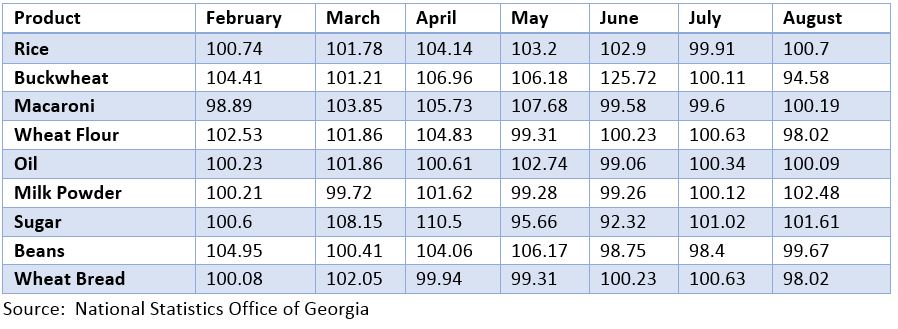Resume: According to the Treasury Service’s budget execution report, expenses for the Price Preservation on Basic Food Products state programme (state programme code 310518) amounted to GEL 4 million as of April 2020 whilst the total expenses from the programme’s budget reached GEL 9 million as of May. Therefore, the government spent GEL 9 million of the GEL 10 million allocated for the programme instead of GEL 5.6 as stated by the Deputy Minister of Environmental Protection and Agriculture. In regard to the prices of the aforementioned products, the prices of seven of nine basic food products as determined by the authorities increased significantly in the first month of the implementation of the programme (with the exception of cooking oil and wheat bread). In May, prices of wheat and bread as well as milk powder and sugar dropped whilst prices for the rest of the products again increased. Given these circumstances, the claim that the programme’s function was successfully carried out is an exaggeration and does not correspond to the truth.
Analysis
The First Deputy Minister of Environmental Protection and Agriculture, Giorgi Khanishvili, in his interview with Interpressnews provided his evaluation of the price insurance programme vis-à-vis nine food products and stated: “The programme absolutely handled the task. Initially, over GEL 4.5 million of the GEL 10 million allocated for the programme was spent on the stability of wheat prices whilst GEL 1,150,000 was spent for the rest of the products. The programme’s function was successfully carried out.”
On 23 March 2020, Georgia adopted the State Programme on Price Preservation on Basic Food Products. The programme’s budget was set at GEL 10 million. According to the programme, the government should provide insurance for preserving the prices for nine food products (rice, buckwheat, macaroni, cooking oil, flour, wheat, milk powder, sugar and beans).
These products are mostly imported to Georgia. With this programme, the Government of Georgia offsets the currency exchange difference to food importers meaning that the USD to GEL exchange rate was fixed at GEL 3 (USD 1 – GEL 3) and the EUR to GEL exchange rate was fixed at GEL 3.3 (EUR 1 – GEL 3.3). Any extra costs for importers over GEL 3 in the case of USD and over GEL 3.3 in the case of EUR is subsidised by the government. For instance, if the price of an imported product is GEL 3.5, the difference between the prices (GEL 0.5 in the case of USD and GE 0.2 in the case of EUR) is paid by the government.
As mentioned previously, according to Giorgi Khanishvili’s statement, GEL 5,650,000 of the GEL 10 million allocated for the programme has been spent.
According to the Treasury Service’s budget execution report (since the programme’s duration was set from 15 March 2020 to 15 May 2020, FactCheck analysed the budget execution reports of the respective months) as of April 2020, expenses for the Price Preservation on Basic Food Products state programme (state programme code 310518) amounted to GEL 4 million whilst the total expenses from the programme’s budget reached GEL 9 million as of May. Therefore, government spent GEL 9 million of the GEL 10 million allocated for the programme, instead of GEL 5.6 as stated by the Deputy Minister of Environmental Protection and Agriculture.
The aim of the state programme on Price Preservation on Basic Food Products was to keep retail prices on the aforementioned product whilst the programme’s task was to halt price growth on prices through subsidies and incentivising a stockpiling of necessary products in the country.
In order to measure how successfully the programme’s goals were achieved, FactCheck analysed the price growth dynamic on the nine products included in the programme.
Table 1: Consumer Price Index on Nine Products (Previous Month = 100)

As illustrated by Table 1, in the first month (April) of implementation of the programme, of nine basic food products determined by the authorities, prices on seven increased significantly (with the exception of cooking oil and wheat bread). In May, prices on wheat and bread as well as milk powder and sugar dropped, whilst prices for the rest of the products increased again. Given these circumstances, claim that the programme’s function was successfully carried out is an exaggeration and does not correspond to the truth.
In regard to the programme’s task to create necessary stockpiles of product, Georgia has not indeed experienced shortage of the product covered by the programmes. Import of wheat - the most important staple food – has increased in the reporting period. In March-May 2020, in total USD 29,433,200 value wheat, which constitutes 135,013 tons were imported to Georgia, which is 27% more monetarily speaking and 35% more in volume as compared to the same period of the previous year (see FactCheck’s article). In this period, average wheat price was USD 198.
In the aforementioned period, share of Russia-imported wheat constituted 98% of total wheat imports, whilst 2% was imported from the USA. The necessity to diversify wheat imports has become particularly vivid in light of the coronavirus pandemic. To ensure the country’s food safety, it is of paramount importance to have diversified wheat imports to avoid risks of supply interruption and be less dependent on such unreliable trade partner as Russia, which often uses trade relations with Georgia for political purposes.







